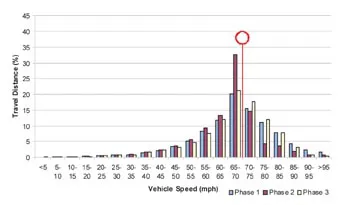Oliver Carsten, Professor of Transport Safety at the Institute for Transport Studies (ITS) at the University of Leeds, UK, discusses Intelligent Speed Adaptation, looking at its safety potential
February 22, 2012
Read time: 6 mins

Oliver Carsten, Professor of Transport Safety at the Institute for Transport Studies (ITS) at the University of Leeds, UK, discusses Intelligent Speed Adaptation, looking at its safety potential
Intelligent Speed Adaptation (1311 ISA) is the system that brings the speed limit inside the vehicle. Usually based around the same technologies as Satnav (GPS-based positioning and an on-board digital road map), it can take the form of advisory ISA (a device that warns the driver about speeding), voluntary ISA (a device that deters speeding by requiring the driver to deliberately override the system in order to speed), and mandatory ISA (no speeding possible).
Few systems have been investigated as intensively as ISA. There have been real-world trials in Sweden, the Netherlands, Denmark, Belgium, Australia, Spain, Hungary, France and the UK. The large interest in the system's safety potential is not all that surprising. In our recent project on behalf of the UK Commission for Integrated Transport and the Motorists' Forum, looking at the potential benefits of ISA, we used standard models of the relationship between road speed and crash risk to examine the safety impact of ISA. We calculated that full compliance with the speed limits on British roads would result in a reduction of 29% in injury accidents. The reductions in serious and fatal accidents would be substantially greater - approximately 50% for fatal crashes. Countries with greater problems of speeding than Great Britain would save even more
The trials that we conducted in 2004 to 2006 on behalf of the1439 UK Department for Transport revealed that a voluntary ISA system had a considerable effect on speeding behaviour as well as a high degree of acceptance among the drivers. The drivers were selected across a range of characteristics including gender, age, private or fleet and general intention to speed or not to speed. Driving with ISA produced virtually no change in speed choice below the limit, but had a marked impact on top-end speeds.
In spite of the possibility to override the ISA at will, driving with ISA available reduced 85th percentile speed on 30mph (approximately 48km/hr) urban roads by approximately 2.5mph (4km/hr) and the proportion of distance travelled when driving over the speed limit declined from 40% to 35%. On 70mph roads (112km/hr), 85th percentile speed fell by over 4 mph (6km/hr) and the proportion of distance travelled when driving over the speed limit declined from 31% to 25%. These numbers may not appear to be very dramatic, but with ISA very large excess speeds became a rarity. It should also be noted that our ISA system allowed some limited speed excursion before it cut in.
Figure 1 shows the speed distribution of the drivers when driving on 30mph roads. The Phase 1 bars show driving in the first month without ISA. Phase 2 covers the four months with ISA and Phase 3 represents the last month when ISA was switched off again. The effect of driving with ISA was to substantially curtail high speeds and there was no discernible effect of the system on the distribution of speed at the lower end. This shows that drivers were not on "autopilot". Because the drivers were able to override the system, there was still some driving above the speed limit. In Phase 3, when the ISA was withdrawn, behaviour reverted to that observed in Phase 1.
We also investigated acceptance of ISA. We used a scale that measures both "usefulness" (how good is it for the traffic system?) and "satisfaction" (how much does it fulfil my goals?). Usefulness was positive throughout. Satisfaction was mildly negative during early acquaintance with ISA, but after that became positive and was most positive after ISA was withdrawn. This indicates that the participants regretted losing ISA.
Figure 3 shows intention to speed over time. ISA reduced not only the actual propensity to speed as discussed earlier but also intention to speed. In other words use of ISA acted as a kind of vaccination against wanting to speed, and the effect persisted into the after period.
We also examined the long term accident reduction penalty of ISA and carried out a cost-benefit analysis that, on the benefit side, considered both the accidents saved with ISA and reduction in fuel consumption and CO2. We looked at two scenarios of the future. The first was a Market Driven scenario with relatively slow adoption of ISA and the ISA systems chosen generally tending to be the less effective advisory ones. The other scenario was an Authority Driven one, in which fitment of Voluntary ISA on new vehicles became required and in which, once virtually every vehicle had ISA, it became compulsory to use it. Table 1 compares the numbers of crashes saved under the two scenarios over the period 2010 to 2070. It can be seen that the Authority Driven scenario is far more effective.
Table 1: Crashes saved 2010 to 2070
Market Driven SlightCrashes 4%
Market Driven Serious Crashes 8%
Market Driven Fatal Crashes 13%
Authority Driven Slight Crashes 15%
Authority Driven Serious Crashes 25%
Authority Driven Fatal Crashes 30%
The overall benefit to cost ratios (BCRs) calculated are 3.4 for the Market Driven scenario and 7.4 for the Authority Driven scenario. In both cases almost all the costs are attributable to the in-vehicle equipment. These BCRs mean that both of the alternative futures are fully justifiable in terms of social investment, but
the more forceful scenario clearly has greater pay-off.
Thus it can be seen that both scenarios are "winners" but benefits are tied very closely to the form of ISA and the rate of adoption. Indeed, the harder the push for ISA, and the "stronger" the system, the greater the benefits.
It should be noted that ISA can potentially deliver far more than was considered in this analysis. For example, it was assumed that, apart from the introduction of ISA, there would be no fundamental changes in the speed management regime. But ISA could deliver 20mph zones for virtually no cost, since all that would be required would be an alteration in the speed limit map. There would be no need for all the costly infrastructure changes normally associated with 20mph zones.
ISA could also be employed dynamically, with the addition of a communications interface. This would enable dynamic speed management to be extended to the whole road network. In the long run, we might get away completely from having fixed speed limits.
The conclusion is that here is a system with very large safety potential. Whether that potential is fully exploited will be determined by the political process.
Reputation for excellence
The Institute for Transport Studies (ITS) at the University of Leeds, UK, is Europe's largest single academic5432 Department for Transport teaching and research, enjoying a worldwide reputation for excellence.
For almost 40 years it has provided policy-makers with the evidence to underpin sound decision-making, keeping a watchful eye on the impacts of new developments to see how technology can help create safer, cleaner, more efficient and sustainable transport.~Reputation for excellence.
The Institute for Transport Studies (ITS) at the University of Leeds, UK, is Europe's largest single academic department for transport teaching and research, enjoying a worldwide reputation for excellence.
For almost 40 years it has provided policy-makers with the evidence to underpin sound decision-making, keeping a watchful eye on the impacts of new developments to see how technology can help create safer, cleaner, more efficient and sustainable transport.
Oliver Carsten is Professor of Transport Safety at ITS, which has one of the UK's pre-eminent research groups on transport safety. He is chair of the Road User Behaviour Working Party of the UK's Parliamentary Advisory Council for Transport Safety (PACTS) and expert advisor to the European Transport Safety Council (ETSC).
Oliver Carsten is Professor of Transport Safety at ITS, which has one of the UK's pre-eminent research groups on transport safety. He is chair of the Road User Behaviour Working Party of the UK's Parliamentary Advisory Council for Transport Safety (PACTS) and expert advisor to the European Transport Safety Council (ETSC).
Intelligent Speed Adaptation (
Few systems have been investigated as intensively as ISA. There have been real-world trials in Sweden, the Netherlands, Denmark, Belgium, Australia, Spain, Hungary, France and the UK. The large interest in the system's safety potential is not all that surprising. In our recent project on behalf of the UK Commission for Integrated Transport and the Motorists' Forum, looking at the potential benefits of ISA, we used standard models of the relationship between road speed and crash risk to examine the safety impact of ISA. We calculated that full compliance with the speed limits on British roads would result in a reduction of 29% in injury accidents. The reductions in serious and fatal accidents would be substantially greater - approximately 50% for fatal crashes. Countries with greater problems of speeding than Great Britain would save even more
The trials that we conducted in 2004 to 2006 on behalf of the
In spite of the possibility to override the ISA at will, driving with ISA available reduced 85th percentile speed on 30mph (approximately 48km/hr) urban roads by approximately 2.5mph (4km/hr) and the proportion of distance travelled when driving over the speed limit declined from 40% to 35%. On 70mph roads (112km/hr), 85th percentile speed fell by over 4 mph (6km/hr) and the proportion of distance travelled when driving over the speed limit declined from 31% to 25%. These numbers may not appear to be very dramatic, but with ISA very large excess speeds became a rarity. It should also be noted that our ISA system allowed some limited speed excursion before it cut in.
Figure 1 shows the speed distribution of the drivers when driving on 30mph roads. The Phase 1 bars show driving in the first month without ISA. Phase 2 covers the four months with ISA and Phase 3 represents the last month when ISA was switched off again. The effect of driving with ISA was to substantially curtail high speeds and there was no discernible effect of the system on the distribution of speed at the lower end. This shows that drivers were not on "autopilot". Because the drivers were able to override the system, there was still some driving above the speed limit. In Phase 3, when the ISA was withdrawn, behaviour reverted to that observed in Phase 1.
We also investigated acceptance of ISA. We used a scale that measures both "usefulness" (how good is it for the traffic system?) and "satisfaction" (how much does it fulfil my goals?). Usefulness was positive throughout. Satisfaction was mildly negative during early acquaintance with ISA, but after that became positive and was most positive after ISA was withdrawn. This indicates that the participants regretted losing ISA.
Figure 3 shows intention to speed over time. ISA reduced not only the actual propensity to speed as discussed earlier but also intention to speed. In other words use of ISA acted as a kind of vaccination against wanting to speed, and the effect persisted into the after period.
We also examined the long term accident reduction penalty of ISA and carried out a cost-benefit analysis that, on the benefit side, considered both the accidents saved with ISA and reduction in fuel consumption and CO2. We looked at two scenarios of the future. The first was a Market Driven scenario with relatively slow adoption of ISA and the ISA systems chosen generally tending to be the less effective advisory ones. The other scenario was an Authority Driven one, in which fitment of Voluntary ISA on new vehicles became required and in which, once virtually every vehicle had ISA, it became compulsory to use it. Table 1 compares the numbers of crashes saved under the two scenarios over the period 2010 to 2070. It can be seen that the Authority Driven scenario is far more effective.
Table 1: Crashes saved 2010 to 2070
Market Driven SlightCrashes 4%
Market Driven Serious Crashes 8%
Market Driven Fatal Crashes 13%
Authority Driven Slight Crashes 15%
Authority Driven Serious Crashes 25%
Authority Driven Fatal Crashes 30%
The overall benefit to cost ratios (BCRs) calculated are 3.4 for the Market Driven scenario and 7.4 for the Authority Driven scenario. In both cases almost all the costs are attributable to the in-vehicle equipment. These BCRs mean that both of the alternative futures are fully justifiable in terms of social investment, but
the more forceful scenario clearly has greater pay-off.
Thus it can be seen that both scenarios are "winners" but benefits are tied very closely to the form of ISA and the rate of adoption. Indeed, the harder the push for ISA, and the "stronger" the system, the greater the benefits.
It should be noted that ISA can potentially deliver far more than was considered in this analysis. For example, it was assumed that, apart from the introduction of ISA, there would be no fundamental changes in the speed management regime. But ISA could deliver 20mph zones for virtually no cost, since all that would be required would be an alteration in the speed limit map. There would be no need for all the costly infrastructure changes normally associated with 20mph zones.
ISA could also be employed dynamically, with the addition of a communications interface. This would enable dynamic speed management to be extended to the whole road network. In the long run, we might get away completely from having fixed speed limits.
The conclusion is that here is a system with very large safety potential. Whether that potential is fully exploited will be determined by the political process.
Reputation for excellence
The Institute for Transport Studies (ITS) at the University of Leeds, UK, is Europe's largest single academic
For almost 40 years it has provided policy-makers with the evidence to underpin sound decision-making, keeping a watchful eye on the impacts of new developments to see how technology can help create safer, cleaner, more efficient and sustainable transport.~Reputation for excellence.
The Institute for Transport Studies (ITS) at the University of Leeds, UK, is Europe's largest single academic department for transport teaching and research, enjoying a worldwide reputation for excellence.
For almost 40 years it has provided policy-makers with the evidence to underpin sound decision-making, keeping a watchful eye on the impacts of new developments to see how technology can help create safer, cleaner, more efficient and sustainable transport.
Oliver Carsten is Professor of Transport Safety at ITS, which has one of the UK's pre-eminent research groups on transport safety. He is chair of the Road User Behaviour Working Party of the UK's Parliamentary Advisory Council for Transport Safety (PACTS) and expert advisor to the European Transport Safety Council (ETSC).
Oliver Carsten is Professor of Transport Safety at ITS, which has one of the UK's pre-eminent research groups on transport safety. He is chair of the Road User Behaviour Working Party of the UK's Parliamentary Advisory Council for Transport Safety (PACTS) and expert advisor to the European Transport Safety Council (ETSC).








